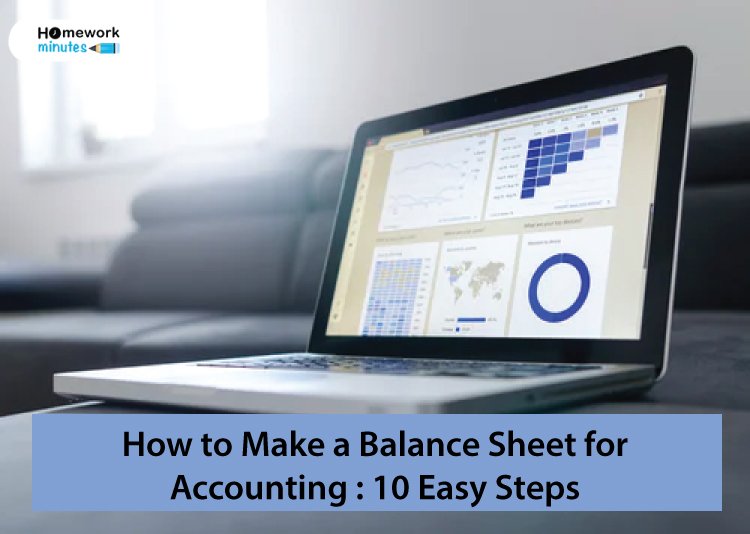If you’re an accounting major, there are a few significant terms that you have to know. To start with, an income statement, the statement of cash flows, and the balance sheet. If taken from the most important of the lot, it is crucial to know how to balance the sheet. If you’re pursuing your studies as a business major, you’re likely to become a part of a business organization shortly. Hence, it is good to have a fair hand at making the company’s balance sheet as per its frequency of reporting the financial statements. In this guide, we’ll walk you through the basics of the balance sheet and its making.
Also read:-
What is a Balance Sheet?
Before knowing how a balance sheet works, let’s know what it means for a start. A balance sheet is a financial statement that depicts the total assets, liabilities, and net worth of the businesses. To put it otherwise, it investigates the financial health of the business. With this financial statement’s help, the businesses can inform lenders, investors, or the key holders about their business. Moreover, it’s a snapshot of the company’s past and present performance and a prospect of future performance.
The basic formula that supports the making of any balance sheet is:-
Assets = Liabilities + Shareholder’s Equity
Let’s understand the three key terms involved in making a balance sheet for accounting.
1. Assets
Assets are the company’s valuables that are quantifiable, could be liquidated, and later turned to cash. In short, these are the goods and resources that a company owns. The term assets further break up into two categories, namely current assets and non-current assets. While the former is what a company expects to convert into cash within a year, the latter are long term investments.
Examples:
Current Assets – Inventory and Cash/ cash equivalents
Non-current Assets – Land, patents, and trademark
2. Liabilities
To simplify liabilities, these are the company’s valuables that they owe to a debtor. For instance, these may refer to the payroll expenses, rent, and taxes or payable bonds. Liabilities to further break up into current and non-current liabilities. While the former are ones due within a year, the latter is unexpected to be paid in a year.
Examples:
Current Liabilities – Account payable
Non-current Liabilities – Leases, bonds, and loans
3. Shareholder’s Equity
Short and simple, it is the company’s net worth, left after selling all the assets and paying the liabilities. The basic equation that each company has to fulfill is:-
Shareholders’ Equity = Assets – Liabilities
Now that you’re well-acquainted with the terms that make up the basics of a balance sheet, here’s how to prepare one.
How to Prepare a Balance Sheet
Whether you use an accounting system or program, it is advisable to know the basics of a balance sheet for error-tracking. Here are the series of steps that you must follow for a properly balanced sheet.
1# Setting Up the Balance Sheet
Step 1: Use a basic accounting equation to make a balance sheet
Assets = Liabilities + Shareholder’s Equity
Step 2: Choose the correct date for making a balance sheet
The businesses are most likely to make their balance sheet quarterly (the last day of March, June, September, or December) or at the end of the fiscal year (December 31).
2# Prepare the Assets Section
Step 3: List all the current assets and calculate the total current assets
This section will include all that can be liquidated into cash within one year of the balance sheet date.
Step 4: List all the non-current assets or, as you may call it, the long term assets
The general ledger in the section will indicate the current value of the long-term assets.
You can also keep a column for intangible assets that mainly include patents, copyright, trademarks, etc.
Step 5: Add up the current and non-current assets under “Total Assets”
3# Prepare the Liabilities Section
The section for the liabilities proceeds just like the assets section.
Step 6: Determine the current liabilities
These are the liabilities due to one of the balance sheet dates. The subtotal of the current liabilities is “Total Current Liabilities.”
Step 7: Calculate the long term liabilities, also known as fixed liabilities
Preceding this, add the current liabilities subtotal to the long-term liabilities subtotal.
4# Calculate Owner’s Equity and Totals
Step 8: Calculate the retained earnings
Step 9: Calculate the owner’s equity
Step 10: Add up the ‘Total Liabilities’ and ‘Total owner’s equity’ figures
By following up with these ten steps, you’ll get the resultant balance sheet, which is a critical financial statement for checking the company’s financial health.
If you want to get help with more such accounting or financing account help, seek instant online assignment help. We provide 24*7 tutorials from professionals. Chat with us!


